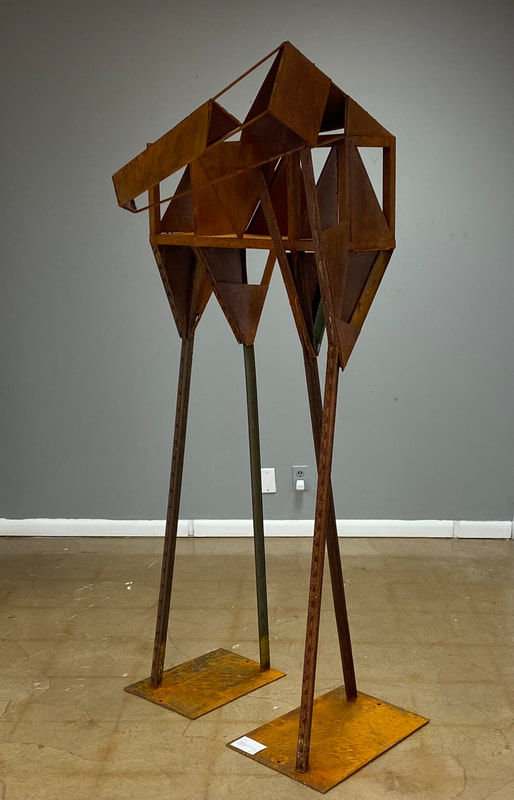butch Murphy: Seeing Horses (and Other Objects) From All Angles
- Bob Bahr

- Jul 13
- 4 min read
Updated: Jul 15
One of the most important ways that sculpture is different from a 2-D artform like painting is that viewers usually see different sides of a sculpture. The viewer has several distinct experiences of a piece just by walking around it.
butch Murphy appreciates this aspect of 3-D art, in part because of his fondness for Cubism. That art movement, which began around 1907, tried to take the experience of seeing something from several perspectives and combine several views into one. For example, a painting of a face may show both a straight-ahead view and a side view. Think of Pablo Picasso's work in this era.

"I saw a Picasso show at the Nelson-Atkins Museum that featured the beginnings of Cubism and it really blew my mind," says Murphy. More subtly, Murphy draws inspiration from Georges Braque, who not only explored showing more than one perspective, but also built up layers of paint (into what the art world calls impasto), thus making the 2-D painting feel 3-D. Murphy builds up layers in metal in places on his sculptures to create a similar effect.
The Cubists often broke down elements of a painting's subject matter into geometric shapes. Most literally, a building can be rendered as a simple cube. And planes break down into triangles, catching the light in expected and unexpected ways. Murphy sculpts in similar fashion.
"The Cubists influenced me in terms of geometric parts," Murphy confirms. "I may exaggerate certain parts of the image, the parts that drew me. I took geometry in summer school in 10th grade, and a lot of it stuck. Geometry is in everything in your life; it's in everything you do. And when you use a geometric shape, it transforms things. It also offers some perfection because it gives me sharp edges, and yet it's abstracted. Sometimes I just like to use geometric shapes--it's just fun. To do it all with triangles was especially fun."
Why?

"Because if you walk just five degrees to one side or the other of the sculpture, the triangles closed up the space," Murphy explains. "There's a sense of transparency in one view and solidity in another view. Empty spaces create a different appreciation of the stance of the figure. It does look completely different from each angle. I've even turned them upside down to work on the belly of a horse sculpture so if someone looks at it from below they get another perspective."
Murphy has been focusing on horses lately, which are ideal subjects for a sculpture because most humans have the idea of a horse imprinted deeply in their brains. We know the symbol and the posture of a typical horse. This offers an opportunity. The artist doesn't make his horses look quite literal in their representation--he doesn't need to. We get "horse" with just a few visual clues.
One piece had a head at both ends. Murphy says it may represent the birth of a foal, but he doesn't want to nail it down for the viewer. "I've found that people see so many things in a piece that I didn't think of," he says. "I like to keep it ambiguous and let them make their own piece from it. Fill in the spaces on your own. I will focus on parts of horses and put them where they are not supposed to be, rather than make a straightforward horse."
Why horses?
"I wish there were some fantastic answer," says Murphy. "I was looking at some horse sculptures by Doug Owen, of Colorado, and I thought I would give that a try. I did about seven of those in his style. He was very complimentary but said I needed to find my own path. I grew up near Tulsa and rode horses a little bit, but it wasn't a big part of my life. They just offer a lot of opportunities, and I haven't really wanted to go with any other animal. Bison, cows--they're just not me. There's no limit to any of this because the sculptures are abstract."

Murphy says he prepares to make a sculpture by enacting the pose that the horse will be in with his own body. "If somebody was looking into my studio, they might see me trying a stance," he says. It doesn't matter that he is not a horse, or even a quadruped. "It's more a state of mind than a pose; it's my state of mind, rather than the horses."
The artist welds his sculptures from rebar and found objects--plus sheet metal. He prowls scrapyards for finds. "My tetanus shots are up to date," says Murphy. He taught himself how to MIG (Metal Inert Gas) welding. The artist says it is getting harder to get up on scaffolding to work on larger pieces, but it's enticing. "I made two 10-foot sculptures that I really like," says Murphy. "The bigger they are, the less you have to worry about them being perfect."






Comments